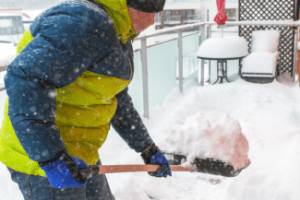Winter is Coming
This month, we talked about winterization during our morning coffee here in my part of Virginia. We are fortunate not to get too many winter storms, but as a result, sometimes we are caught off-guard. The session focused on prepping for big freezes or storms. It included practical tips like turning the heat on in your vacants, checking for out-of-town residents to ensure their heat is on, setting faucets to drip, and opening your cabinet doors. They mentioned checking faucets outside and walking the property to make sure that you don’t have dead limbs around the buildings. All great suggestions, but it got me thinking about other things property managers should be doing long before any storm or winter weather gets to their property.
Winter Storm Prep

On your winter map, you can also note hard-to-thaw places that get icy (north-facing shady doors) and places where water runs off the buildings and sits on sidewalks or roads and refreezes. For example, in the map below, we would only have one maintenance person on this property, and it would take him days to shovel all the sidewalks. We make a practical plan. 1. Office and shop. 2. Getting residents to their cars. 3. Left to right movement. I would circle our residents who need help and checked on. It’s not shoveling straight down the sidewalk like people tend to do if they don’t have a plan.
2. Salt and Shovels. When a storm is coming, supplies are sometimes slow to arrive because of demand. Have a bit of salt and make sure you know where your snow shovels are at the start of the season (make sure the handles aren’t falling off, she says from personal experience).You should salt before the storm most of the time, and you use WAY TOO MUCH, I can almost guarantee. Salt pollutes our waterways, so train your team to use less. Salt should be spread out with a 3-inch gap. A coffee mug full of salt is enough to treat a 20-foot driveway or ten sidewalk squares. Read the bag! Salt only where you need it. Remember, different salts work at different temperatures, and most we use are chloride-based, which isn’t the best for pets or kids.
- Rock salt (Sodium Chloride) isn’t the best product, and it only works down to 20 degrees. Putting it down before a cold freeze won’t do much, but it is cheap and might help for a mild storm. I don’t recommend this product.
- Calcium Chloride works down to -25, but is hard on your grass and can pock concrete.
- Potassium Chloride doesn’t work as well as the other two, but won’t kill your grass.
Mixing sand with salt can increase traction, help you use less salt, and assist if the sidewalk gets too cold for the salt you are using.
3. Before the storm, before the winter, make sure your employees know expectations. If maintenance is emergency personnel, but they can’t get the car out of their neighborhood, do they have to take PTO? When do the teams report, at a certain time or after the snow stops? This really depends on the storm. Sometimes, I see maintenance out shoveling in the snow, and it’s going to snow more, and they are going to have to re-shovel the same places. But sometimes, there will be so much snow that a break gives you a head start on the heap. Discuss various options and have notes (on your winter map) about various plans you can think through, and then make sure to meet before the event to discuss the details of each storm based on the forecast.
4. Coach on proper snow shoveling, winter clothing, and make sure your people know they come first. Did you know a shovel of wet snow is 16 pounds? Shoveling is a dangerous activity as it can cause a lot of stress on the heart. If your team has to lift snow, consider having a class on the squat, lift, push method to avoid injury before every storm. If you have single or part-time maintenance team members on a small property, will you be hiring extra help? Do you have sister properties who can spare resources? Some landscapers offer support, and often your temp services will bulk up their availability to have people available to help clear up after a storm. If you have it in your budget a snow blower saves lives (and if you can share with your sister communities, isn’t that hard on the budget, but does have to be stored properly when not in use). Make sure that your team is well insulated and has proper gear for being outdoors, and knows the signs of frostbite.
Paying Too Much For Insurance?
Get a FREE quote to insure your rental properties for less.
5. Post-storm, remove the salt from your sidewalks if you can. If you can sweep it up, you can reuse it, and it keeps it from polluting waterways. Make a note of places that iced over or were super slippery on your snow map so you can address them early next time.
PS. I’m a fan of maps of quick ways to store info in urgent situations. Here’s what I recommend you have for maps of your property.
- Natural gas shutoffs
- Water shutoffs
- Master water meter locations
- Main water lines
- Sprinkler system main cutoffs
- Fire hydrant locations
- Sewer clean outs and main runs
- Electrical shutoffs and transformers
- Exterior lighting control locations
- Swimming pool operation and valves (schematic)
- Fire alarm pull station locations and main control panels
- Television cable line runs
- Plot map showing property lines and easements
- Emergency controls for access gates (if applicable)
- Master telephone boxes
- Winter plan
Source: Multifamily Insiders















 Accessibility
Accessibility